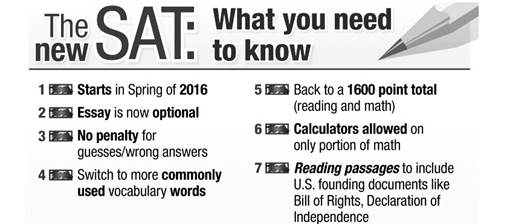Re-SAT-ing the exam

March 27, 2014
When news erupted that College Board had finally decided to revamp its long dreaded SAT by the spring of 2016, many were hopeful for changes that would alleviate the problems of the current exam.
This overhaul of the assessment, however, is not made for the well being of high students, but instead for business reasons, or the SAT’s competition against the ACT to be more specific. In fact, some have argued that the changes made are only a cover-up to the critical problems of the SAT and not an actual solution.
College Board President David Coleman has ensured parents and students that the improved SAT would even out the playing field and lessen the advantage given to students who are from upper income families and take many afterschool tutoring classes. College Board guarantees that the new exam will be more relevant to topics learned in school. It has even started a partnership with Khan Academy to provide free online instructional videos to aid students in need.
But this approach will be made in vain; regardless of the changes, education programs like Kaplan and Princeton Review will still find ways to teach the SAT and disrupt the average score balance between students. Instructional videos have always existed on YouTube and other media sites; adding more videos will not solve the basic problem of students’ lack of interest in learning the topics for the test without a tutor.
The other modifications (see chart) to the SAT only offer minor changes that will not solve the imbalanced education between students. Sure, the questions will be altered to force students into backing up their answers with specific facts from the text and improve their analyzing skills in the reading sections. It is also great that College Board is finally removing obscure English vocabulary terms and narrowing down the math section into three key areas. Yet, the major troubles will still exist.
On average, higher income families will still score better than lower income families. Bad test takers will still do poorly on the test that holds crucial value in deciding their future college. Students at top-notch high schools will still be raising the bar to incredible heights and putting students at a lesser high school at a disadvantage. Though they sound nice on paper, the adjustments to the SAT will, in reality, change nothing.
Over the past two years, the number of students who choose to take the ACT has actually increased to exceed the number of students that take the SAT. This stiff competition has been the real catalyst behind the overhaul of the SAT. As a result, the new SAT will mirror characteristics of the ACT by no longer have a guessing penalty and by making its essay optional. In reality, this transformation has all been about business and not about the improvement of America’s education. Instead of encouraging individuals to be more exact on their answers and work on their writing skills, the new SAT will send out the message that guessing is fine and writing is a choice, not a necessity.
For a country that should be striving toward improvement and success, America seems to be lowering its standards. The SAT has long been criticized for being an inaccurate measurement of one’s proficiency for college and the changes that it has made are still far off from being an adequate solution to the problems that it faces.








